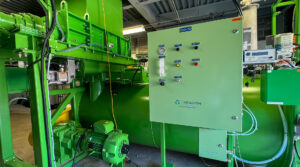While adding non-regulated waste containers to rooms, it’s also beneficial to educate hospital personnel on what qualifies as RMW waste. Include eligible versus non-eligible signage near red bags and cans while setting up a time to meet on the topic to field any questions.
#2: Minimize Single-Use Medical Devices
While single-use medical devices have their time and place, reusable medical devices are the more sustainable choice when possible. These reusable devices fall into one of three categories:
- Critical devices: Come in contact with blood or normally sterile tissue (E.g.: Surgical forceps)
- Semi-critical devices: Come in contact with mucus membranes (E.g.: Endoscope)
- Non-critical devices: Come in contact with unbroken skin (E.g.: Stethoscope)
#3: Leverage an Ozone Treatment Process
 Infectious waste–any waste that’s capable of transmitting communicable disease—can be found in pathological waste, infectious sharps, or biological cultures. By exposing the waste’s surface area to ozone for a sustained period of time, ozone treatment sterilizes materials and prepares them for disposal.
Infectious waste–any waste that’s capable of transmitting communicable disease—can be found in pathological waste, infectious sharps, or biological cultures. By exposing the waste’s surface area to ozone for a sustained period of time, ozone treatment sterilizes materials and prepares them for disposal.
One benefit of ozone treatment is overall emissions reduction. The speed of ozonation cuts back on electric consumption, while no post-process waste or residue means you can reduce trips to the landfill. Compared to alternatives like incineration, the ozone treatment process can reduce greenhouse gas emissions by up to 50%.
#4: Put an End to the Paper Trail
Many hospitals still rely on paper-based systems to support their operations. Moving to digital patient registration, implementing eSignature functionality, and using integrated barcode scanners are just a few ways health systems can cut their paper use and costs.
In line with these efforts, make it a point to coach staff on best practices and foster a paper-minimal environment.
#5: Move to the Cloud
While we’re on the topic of digitization, let’s talk about the value of cloud computing in healthcare:
- Patients get secure, on-demand access to medical information and lab test reports
- As hospital or clinical facilities scale, cloud infrastructure is able to grow with them
From a sustainability perspective, hospitals save themselves from having to maintain energy-intensive on-premises servers. Being able to scale digitally without overhauling their physical infrastructure also leads to less electronic waste.
#6: Invest in Solar Panel Roofing 
The San Benito Health Foundation in Hollister, California is a 17,000 square-foot clinic that is nearly 100% solar powered. Thanks to a self-contained micro-grid of solar panels and batteries, the clinic has the ability to rely entirely on sun-fueled energy for up to a week.
Solar energy options like these are growing in popularity across the healthcare industry, and for good reason. Kaiser Permanente, for instance, reported that with a green microgrid for one of their medical office buildings in Hawaii, they’ve reduced their annual electricity costs by nearly $100,000 and decreased greenhouse gas emissions by 400 tons per year.
#7: Electrify Your Fleet
Research shows that EV vehicles currently registered in the U.S. emit up to 68% fewer greenhouse gases than comparable gasoline vehicles. When hospitals switch over to EV vehicles for patient transport and mobile health units—among other examples—they reduce their carbon footprint and improve overall air quality.
Hybrid vehicles and repurposed oil vehicles offer other clean alternatives that lessen a hospital’s overall impact.
#8: Opt for Alternative Modes of Transit
Sustainable transportation can come in many forms, whether it’s carpooling with a group of coworkers or, if located in close enough proximity, biking or walking to work.
In one case, when employees were presented with city bicycle passes and a proper infrastructure, 65% of employees said they’d like to bike to work one to two days per week.
By presenting these types of options to staff, hospitals can not only enhance the lives of urban residents but also reduce traffic congestion, outdoor air pollution, and greenhouse gas emissions.
#9: Use Helium-Free MRI Systems
Helium-light and helium-free MRI systems are affordable while offering most of the same diagnostic capabilities as conventional MRIs. All the while, they reduce carbon emissions related to helium’s energy-intensive extraction and transportation.
While supporting sustainability in healthcare, these smaller, lighter MRI scanners are especially beneficial in areas of hospitals or in specialty clinics where bulkier technology is less feasible.
#10: Embrace Remote Work 
When fewer people are physically present in workplaces—even if only for a few days out of the week—there’s a noticeable impact. From travel to office energy use, full-time remote workers can reduce their carbon footprint by 54%; meanwhile, hybrid employees who work from home two to four days a week can reduce their footprint by up to 29%.
With these variables in mind, hospitals can consider opportunities to move certain roles out of the hospital or adopt a hybrid approach. These departments could include IT, HR, accounting, and administrative support.
Small Steps With a Big Impact
Achieving sustainability in healthcare doesn’t have to mean drastic changes. It can be a series of practical, impactful decisions that add up. From removing red bags from patient rooms to moving to more sustainable vehicle fleets, each meaningful step moves medical facilities closer to reducing their environmental impact.
As a provider of ozone treatment technology for medical waste disposal, WasteMedX can help hospitals and health systems on their way toward a healthier, more sustainable future. Learn more about our process.

 Infectious waste–any waste that’s capable of transmitting communicable disease—can be found in pathological waste, infectious sharps, or biological cultures. By exposing the waste’s surface area to ozone for a sustained period of time, ozone treatment sterilizes materials and prepares them for disposal.
Infectious waste–any waste that’s capable of transmitting communicable disease—can be found in pathological waste, infectious sharps, or biological cultures. By exposing the waste’s surface area to ozone for a sustained period of time, ozone treatment sterilizes materials and prepares them for disposal.



